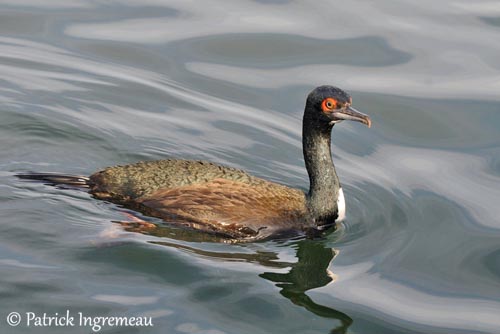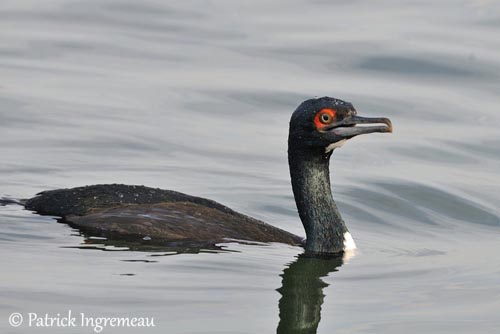
Fr: Cormoran de Bougainville
All: Guanoscharbe
Esp: Cormorán Guanay, Guanay, Guaynay
Ita: Cormorano del guano
Nd: Guanoskarv
Sd: Guanoskarv
Photographers:
Jean Michel Fenerole
Photos d’Oiseaux du monde
Patrick Ingremeau
TAMANDUA
Text by Nicole Bouglouan
Sources:
HANDBOOK OF THE BIRDS OF THE WORLD vol 1 by Josep del Hoyo-Andrew Elliot-Jordi Sargatal - Lynx Edicions - ISBN: 8487334105
L’ENCYCLOPEDIE MONDIALE DES OISEAUX - Dr Christopher M. Perrins - BORDAS - ISBN: 2040185607
BirdLife International (BirdLife International)
Neotropical Birds – Cornell Lab of Ornithology
Arthur Grosset's Birds (Arthur Grosset)
Wikipedia, the free encyclopaedia
Guanay Cormorant - Leucocarbo bougainvillii
Suliformes Order – Phalacrocoracidae Family
INTRODUCTION:
The Guanay Cormorant, also named « the most valuable bird in the world » or « the billion dollar bird », was the greatest producer of guano in Peru, involving phenomenal quantities of money. Between 1848 and 1875, more than 20 000 million tons were sent by ship from Peru to Europe and North America.
For over a century, the guano constituted the main source of Peru’s national income, but the lack of control led to the depletion of the reserves. The continuous extraction of guano caused a great decrease in cormorant’s populations with breeding failures, destruction of the breeding habitat, egg and bird consumption by humans and constant disturbance. This species is today classified as Near Threatened.

DESCRIPTION OF THE BIRD:
Biometrics:
Length: 71-76 cm
The adult has slender body. Head, neck and upperparts are black with bluish-green gloss. The upperwing is blackish with bronzy or brown-olive gloss. The tail is blackish.
On the underparts, the plumage is white on central throat, lower foreneck and entire breast and belly area. Thighs and undertail-coverts are blackish. Underwing and axillaries are blackish too.
Head and neck show some short, white ornamental feathers during the breeding season, and there is an erectile crest on the crown.
The bill is grey to horn-coloured, with blacker culmen and paler lower mandible. The eyes are dark brown, surrounded by narrow, indistinct, whitish outer ring. The eyering is rather yellowish to greenish. The facial skin is red, turning darker or blackish on lores. Gape, base of lower mandible and gular pouch are black. Legs and webbed feet are pale pink with grey tinge.
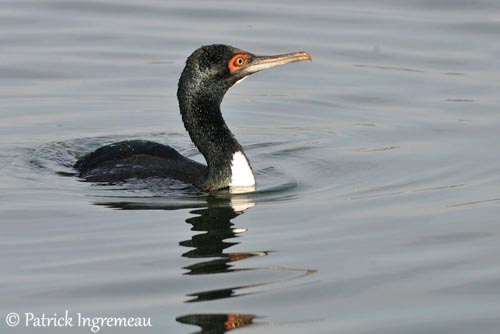
The adult in non-breeding plumage is duller, rather browner, with lacking or reduced crest. Both sexes are similar in plumage, but the female is slightly smaller than the male.
The juvenile is browner than non-breeding adult. The underparts are speckled brown, and the foreneck is variably whitish.
The eyes are greyish. The facial skin is dull brownish, like the bill. Legs and feet are greyer.
The immature has dull orange-pink facial skin and dark eyes. The plumage still shows brown wash on the dark areas.
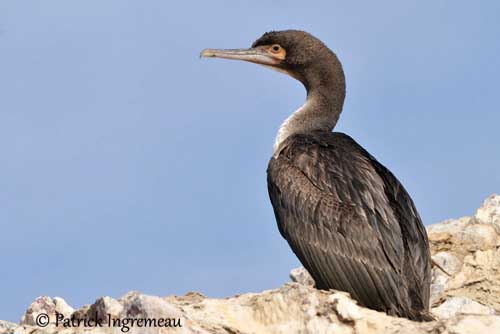
RANGE:
The Guanay Cormorant is a monotypic species. It is found along the coasts of Peru and N Chile. Larger populations occur off C Peru.
It is also present on the coast of SC Argentina, with a small population established in late 1960s, but now almost extinct.
HABITAT:
The Guanay Cormorant is a marine bird. It feeds at sea, in the Humboldt Current’s cold waters. The breeding areas are on remote headlands of the mainland coast and offshore islands off C Peru, usually on gentle slopes.
CALLS AND SONGS:
The Guanay Cormorant, like other cormorant species, is usually silent outside the breeding season. They are vocal at breeding colonies, and these sounds are mainly related to breeding behaviour.
Males are more vocal than females, producing croaking, groaning, barking and gargling sounds. Females may produce softer sounds and hissing.
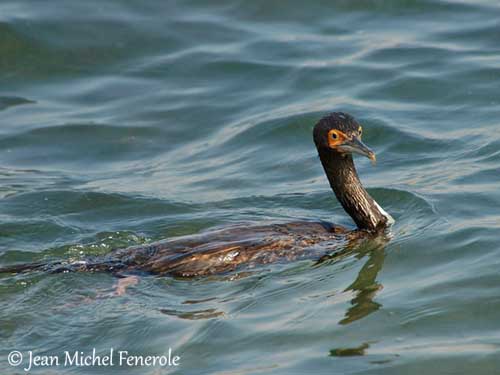
BEHAVIOUR IN THE WILD:
The Guanay Cormorant feeds at sea, mainly on anchoveta (Engraulis ringens). It is very dependent on this food, and the numbers are closely related to food sources’ quantities. The scarcity of these fish due to natural cycles or overfishing by humans, involves rapid repercussions on populations of this species and numerous other seabirds.
The Guanay Cormorant feeds by pursuit-diving. The prey is caught with the bill after rapid pursuit underwater. The bird propels itself thanks to the webbed feet.
This cormorant may fish alone, or in large mobile groups. The birds are on the water, close to each other in a fan-shape. They swim forwards in co-ordinated motion, diving and swimming in unison.
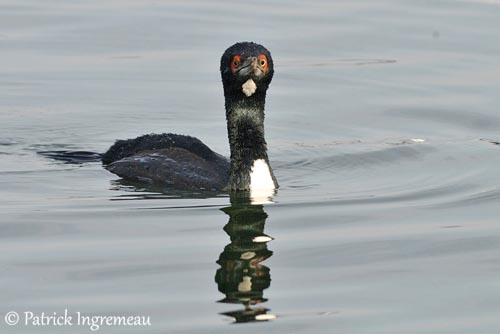
The Guanay Cormorant breeds in dense colonies where 3 nests/m2 are common. It has brighter red facial skin during the breeding season. Its courtship displays are poorly known, but like other cormorants, the male displays from the nest-site to attract a female. Many cormorants perform “wing-waving” and bill pointed upwards or forwards, in order to display the bright red facial skin and the throat pattern.
When a female is accepted by the male, it performs “greeting-displays”. The female remains at the nest-site to guard it, while the male is collecting nest materials. Copulation takes place at the nest-site.
The pair defends a small area around the nest, and fights may occur among rivals. Intruders approaching the nest are attacked and pecked.
The Guanay Cormorant moves N to Ecuador and S to SC Chile after breeding. These dispersions are closely associated to food resources fails due to El Niño’s warm waters. Some vagrants outside the normal range may reach Panama, and extreme S of South America. Others follow rivers and move inland.
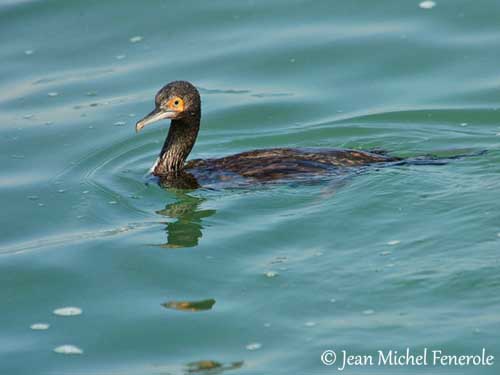
The Guanay Cormorant performs powerful flight with regular, continuous wingbeats, sometimes interspersed with occasional glides. Over water, it usually flies low over the surface, but over land and on long-distance flights, it flies at greater heights. The flocks fly in V-shape or in line.
REPRODUCTION OF THIS SPECIES:
The Guanay Cormorant can breed all year round, but the peak of laying occurs in November/December.
It breeds in huge, dense colonies, usually with Peruvian Brown Pelican (P.o. thagus) and Peruvian Bobby (S. variegata).
The colony is established on flat or gentle slopes. The nest is a pile of excreta, and feathers and debris are added.
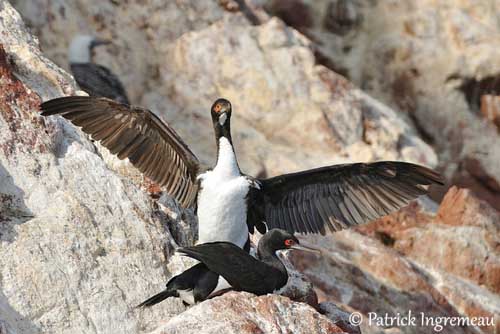
The female lays 2-3 eggs. Incubation lasts between 22 and 26 days. The chicks are naked and helpless at hatching, but they are covered with grey-brown woolly down after a week. Both parents take part in nesting duties. The young fledge about 28 days after hatching.
Nest failure may occur, due to fail of food sources.
PROTECTION / THREATS / STATUS:
The Guanay Cormorant has suffered large declines due to guano exploitation and overfishing. The main threat is the consumption by humans of around 20 000 birds each year in N Peru. Predation by gulls is an important problem too.
Conservation measures are in progress with marine protected areas, but currently, this species is classified as Near Threatened.
